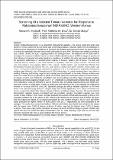| dc.description.abstract | Tomato (Solanumlycopersicum) is an important horticultural vegetable crop among small and large scale
farmers in Kenya, grown for its nutritional and commercial purposes. However, gains from its production is
limited by losses resulting from incidences of Bacterial wilt (Ralstoniasolanacearum) which has proved difficult
to control and drastically decrease tomato yield and quality by up to 80%. The losses vary widely according to
host, cultivar, climate, soil type, cropping practices and pathogen strain. The objectives of this study were to
investigate the response of selected tomato varieties to Ralstoniasolanacearum at different stages of growth and
their tolerance to bacterial wilt under greenhouse conditions. In addition, the study was aimed at investigating
the agronomic performance of selected tomato varieties in Maseno, Western part of Kenya. The study was
conducted between January to July 2013 and June to December 2020. The tomato varieties; ‘Heirloom Tall
vine’ from Johnny’s seed company, Maine, USA; ‘Legend’, ‘Golden Jubilee’, and ‘Goliath Pear Hybrid’ from
Horticultural Products and services Div., WI, USA; and two commercially grown varieties ‘Money maker’ and
‘Cal J’, were grown in dystricnitisol sterilized soil medium in a 23 x 16 cm plastic pots; artificially inoculated at
seedling stage (4 leaves), start of flowering and at 50% fruiting stage. A control experiment (non- inoculation at
seedling, flowering and fruiting stage for each variety) was also included in the study. Disease incidence was
scored on a scale of 0 (no symptoms) to 5 (death of the whole plant). The experiment comprised of three factors;
six tomato varieties, two treatments (Inoculation and non-inoculation) and three stages of growth (seedling,
flowering and fruiting stages) arranged in a 6 × 2 × 3 factorial in a Randomized Complete Block Design with
three replications. Data was collected on days to flowering, days to fruiting, maturity period, plant height (cm),
total yield, number of wilted plants, number of dead plants and response to BW. Data collected was subjected to
Analysis of variance (ANOVA) using SAS Statistical package and effects declared Significant at 5% level.
Means were separated using Duncan’s Multiple Range Test at 0.05 Significance level. Linear correlation was
done to compare the relationship between disease incidences at different stages of growth. The results obtained
demonstrated variation between inoculated and non-inoculated varieties. Inoculated varieties took more
number of days to flower, fruit, mature, and also produced less number of fruits with low weight (g) than in noninoculated varieties due to the effects of BW. Goliath pear Hybrid took the shortest time to flower (42 days),
fruit (59.17days) and mature (73.33 days) but produced the least number of fruits (146.67). Cal J and Money
maker produced the highest number of fruits (209.67 and 191.17 respectively) but were susceptible to the
pathogen. The results also showed that Heirloom Tall vine and Goliath pear Hybrid were tolerant to the disease
with the lowest mean (2.00) of disease incidence. Fruiting stage had the highest mean (3.67) of disease
incidence. There was a high positive correlation in disease incidence at different stages of growth. Goliath pear
Hybrid was found to contain desirable characteristics such as; early maturing, large fruit size and was also
tolerant to Bacterial wilt, hence a good candidate for Kenyan farmers | en_US |

